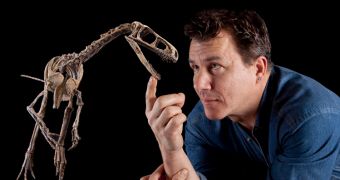Experts announce the discovery of a never-before-seen species of dinosaurs that roamed in South American more than 230 million years ago, when the giant lizards were barely beginning to develop and assume dominance over all ecosystems.
The finding was made by a collaboration of geologists and paleontologists based in Argentina and the United States, and was officially announced yesterday, January 13. It would appear that this species developed right at the middle of the Triassic geological period.
This is the first stage of the Mesozoic Era, which is better known as the Age of Dinosaurs. The giant lizards appeared in the Triassic, developed and diversified extensively during the Jurassic, and reached peak development during the Cretaceous.
The newly-discovered species can therefore be thought of as one of the first and oldest land-based dinosaurs known to science. Reconstructions of the creature show that it weighed only 10 to 15 pounds.
In other words, it was a rather small animal, as demonstrated by the attached photo. It did however feature a long neck and tail, which most likely aided in its balance as the creature was chasing down its prey, or running away from predators.
Scientists have named the new species Eodromaeus, which literally translates into the “dawn runner.” Details of the animal were published in the January 14 issue of the top journal Science.
“It really is the earliest look we have at the long line of meat eaters that would ultimately culminate in Tyrannosaurus rex near the end of the dinosaur era,” explains researcher Paul Sereno.
“Who could foretell what evolution had in store for the descendants of this pint-sized, fleet-footed predator?” adds the expert, who is a National Geographic Explorer-in-Residence, and also a paleontologist at the University of Chicago.
Studying the new species was made easier by the fact that two individuals were found side-by-side, at the Valley of the Moon paleontology site, at the foothills of the Andes mountains. This allowed experts access to a nearly-complete skeleton of the creature.
“Two generations of field work have generated the single best view we have of the birth of the dinosaurs. With a hike across the valley, you literally walk over the graveyard of the earliest dinosaurs to a time when they ultimately dominate,” says Ricardo Martinez.
The expert, who was the lead author of the Science paper, is based at the National University of San Juan, in Argentina. The new work was funded by the Gorden Getty Foundation, the US National Science Foundation, and the National Geographic Society, among others.

 14 DAY TRIAL //
14 DAY TRIAL //